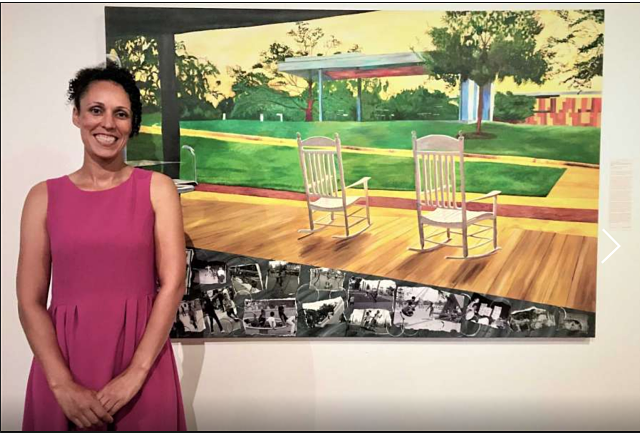 Artist Melissa Aytenfisu with her painting "Metamorphosis of Emancipation Park" at the Houston Museum of African American Culture. Aytenfisu says her dominant greens, yellows and reds hint at the Ethiopian flag of her forefathers. (Photo: Houston Chronicle)
Artist Melissa Aytenfisu with her painting "Metamorphosis of Emancipation Park" at the Houston Museum of African American Culture. Aytenfisu says her dominant greens, yellows and reds hint at the Ethiopian flag of her forefathers. (Photo: Houston Chronicle)
Houston Chronicle
Artist Melissa Aytenfisu’s First Solo Houston Show Combines Painting & Print-making
Melissa Aytenfisu often learns things as a teaching artist at the Museum of Fine Arts, Houston that influence her personal studio practice.
She paints in a photo-realistic, figurative style but she is not above thinking, “I can do that!” when some technique she is explaining to her museum students inspires her. This happened a couple of times leading up to her first solo show in Texas, “Metamorphosis,” which is up through Aug. 22 at the Houston Museum of African American Culture.
She took note of how Latin American artists used found objects to make prints. She saw how Kenyan-born Wangechi Mutu made collages on Mylar. The real driver for Aytenfisu’s recent work, however, was moving to Third Ward in 2018.
“It was the first time I felt inspired artistically,” she says. “I really felt it.”
The show is about “taking something difficult and turning it into something positive,” Aytenfisu says. That covers a lot of ground, including her evolution as an artist and a mother, changes happening in her community and the country, and the process of using found materials that have been through hell to create objects of beauty.
Aytenfisu moved to Houston about seven years ago from her native Canada, landing first in Montrose and scoring her first teaching job at St. John’s School. She did not find the city all that appealing. She married and divorced, then struggled to land on her feet as a single mother with two toddlers.
She moved to Third Ward because it was less expensive but still close to Montrose friends. She did not expect the neighborhood to change her life. But it was the kind of place she could call up a mid-career artist such as Robert Hodge and say, “I don’t know you, but I heard you mentor young artists; would you come and give me a critique?” (That happened, and he did.)
Third Ward has nurtured artists of color since the 1950s, when John Biggers arrived to teach at Texas Southern University. His proteges and the generation that has grown up since the early 1990s through Project Row Houses have made the neighborhood unique not just in Houston, but perhaps in the nation.
This summer, Aytenfisu bought a house on Palm Street, feeling fully “home.” “I’ve never felt so grounded in a community, so connected and inspired – by the people, the energy, the culture, the artistry in the community,” she says.
Finding her voice
Her show, although delayed, was the first by a local artist to open in a Houston museum after the COVID-19 shut-downs. Mayor Sylvester Turner was one of the first visitors in early July, arriving for a private tour with a proclamation declaring it “Melissa Aytenfisu Metamorphosis Day.”
The show’s centerpiece is the large mixed-media landscape “Metamorphosis of Emancipation Park,” depicting a place that has become sacred ground for Aytenfisu. The painting depicts the neighborhood’s recently revitalized, historic heart from the perspective of two rocking chairs that could be sitting on a porch across the street. Its strong colors partly reflect the Fauvism of André Derain.
The French used “fauvist” disparagingly to describe the more savage style of post-Impressionist painters; a word that also was historically applied to Blacks, Aytenfisu says. Her dominant greens, yellows and reds hint at the Ethiopian flag of her forefathers. Paths and tree trunks in magentas, reds and oranges suggest Third Ward’s rich cultural fabric. Collaged black-and-white photographs of park events — some recent, of her kids; some historical — fill a shard at the painting’s base.
Aytenfisu is still finding her voice. The show has a little of this, a little of that, in a modest gallery. Purely painted landscapes and engaging, candid portraits of her kids hint at the traditional origins of her work.
Three collaged watercolors on Mylar — the pieces inspired by Mutu — are her most political and “personal-personal” works, Aytenfisu says. “This is America,” “Land of the Free” and “No Refuge Can Save” convey the stress of becoming a mother, especially a mother of color, in a cruel world. One depicts pregnancy, another childbirth and the other nursing, layering painted figures with news imagery and maps.
“Moving to the U.S., I had more culture shock than I thought I was going to have,” she says. “I’m not saying there is not racism in Canada, but in the US it’s a deeper history.”
—
Join the conversation on Twitter and Facebook.

























